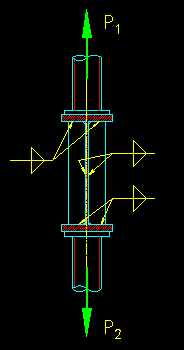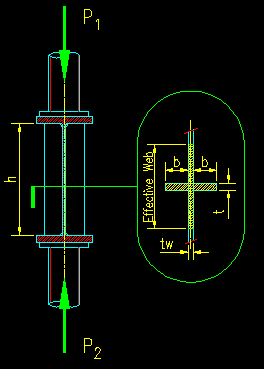|
|
|
|
|
|
|
|
|
|
|
Section 8.6.5
Transverse Stiffeners for Concentrated Loads
Last Revised: 06/22/2023
If a beam has insufficient strength (web local yielding or web crippling) to support concentrated point loads then a pair of transverse stiffeners can be added to the web to transfer the concentrated force to the web. The design requirements for these stiffeners is found in SCM J10.8. You should read this section and its associated commentary section carefully.
Transverse Stiffeners for Tensile Concentrated Loads
|
Figure 8.6.5.1 |
|
|
When the load to be transferred is tensile, the limit state of web local yielding (SCM J10.2) applies when computing the strength of the selected section. If the selected section has insufficient capacity, then a pair of stiffeners are added to carry the load that the section cannot. The stiffeners are designed as any other tension member using the provisions of SCM chapter D.
For the situation depicted in Figure 8.6.5.1, a W section supports two columns at the same location somewhere away from the ends of the member. Both columns have a load case where they are in tension as shown.
Tensile Strength of Stiffeners
The maximum tension on the stiffeners is the maximum of P1 or P2.
The capacity of the unstiffened W section is determined with SCM J10.2.
The required capacity of the stiffeners becomes:
Req'd Stiffener Capacity = max[P1, P2] - Capacity of W section
The design goal for the stiffeners is to determine b and t as shown in Figure 8.6.5.1 such that the limit states of tensile yielding and tensile rupture (SCM D2) are satisfied.
Typically, a corner of the stiffener plates is cut off in the vicinity of the fillet that connects the W section web to the flange (see the SCM J10.8 commentary), resulting in a reduced section for the plates at the flange.
The area calculations are:
Ag = 2bt
Ae = An = 2(b-x)t
These areas are used to compute the SCM Chapter D tensile strength limit state values for the stiffeners.
Stiffener Slenderness
It is advisable to also meeting the slenderness limits found in SCM D1. In this case the critical "r" value for a rectangular cross-section is:
r = sqrt[(bt3/12)/(bt)] = t / [ 2 sqrt(3) ]
and L equals the distance between the inside faces of the flanges:
L = d-2tf
A plate of thickness, t, is chosen to ensure that L/r is less than 300.
t > (2(d-2tf)/300)*sqrt(3)
Connection of the Stiffeners
| Figure 8.6.5.2 Transverse Stiffener Connection Click on image for larger view |
 |
There are three connections to be considered: one each where the stiffeners attach to the flanges and the attachment of the stiffeners to the web. These are shown in Figure 8.6.5.2.
The attachment to each of the flanges must be strong enough to transfer the required forces to the plates. For the example shown,
Req'd Connection Capacity to top flange = P1 - Tensile Capacity of W section web
Req'd Connection Capacity to bottom flange = P2 - Tensile Capacity of W section web
These forces are shared between the two stiffener plates. The force to a single stiffener plate is half of the above.
The force to be transferred to the web of the W section is the difference between the opposing tensile forces:
Req'd Connection Capacity to web = P1 - P2
Again, this force is shared between the two plates.
It is recommended in the SCM commentary on J10.8 that the fillet welds used to make these connections be terminated away from fillet area between the W section web and flange as shown in SCM Figure C-J10.8 (SCM pg 16.1-521).
Other Conditions
The situation given above also works for the condition where there is a concentrated load coming from one side only. In that case, either P1 or P2 equals zero and all the same equations apply. Also, the stiffeners do not need to be full height. They only need be long enough to transfer the force via the welds to the web. This will be a function of the weld strength (i.e., the smaller the weld the longer the transfer length).
If the concentrated loads are near the end of the W section, the only difference is in how the capacity of the W section is determined. See SCM J10.2 for details on this situation.
Transverse Stiffeners for Compressive Concentrated Loads
For the case of compressive concentrated loads, the bearing stiffeners and beam web are treated as built up columns. SCM J10.8 invokes the requirements of SCM E6.2 and SCM J4.4. Compressive bearing stiffeners are to be provided in pairs and be full depth of the member.
The key concept to get from SCM E6.2 is that the individual plates must be attached to meet the requirements of the first paragraph of the section. This limits the spacing of bolt or intermittent welds.
SCM E6.2 refers to governing slenderness ratio of the built-up member. The dimension and effective length for this member are defined in SCM J10.2.
Column Compressive Strength of Stiffeners
The maximum compression on the built-up member that is comprised of the stiffeners and effective area of web is the maximum of P1 or P2.
| Figure 8.6.5.3 Transverse Stiffeners for Compression Click on image for larger view |
 |
The design goal for the stiffeners is to determine b and t as shown in Figure 8.6.5.1 such that the column limit states of SCM J4.4 and/or SCM chapter E are satisfied.
In order to apply the referenced sections, there are a few needed section properties. SCM J10.8 gives the required dimensions to be used. Figure 8.6.5.3 shows the applicable basic dimensions.
The effective column height, KL, is taken as 0.75h. The effective web width (bw) is taken as either 25tw (for "interior" locations) or 12tw (for locations near the end of a beam).
With this information we can compute the section properties. Note that "r" is computed about an axis in the center of the web.
Ag = 2bt + twbw
I = t(2b+tw)3/12 + (bw-t)(tw)3/12
r = sqrt (I/Ag)
According to SCM J4.4, if the member slenderness (0.75h/r in this case) is less than or equal to 25 then the column strength equals the plastic strength:
Pn = FyAg
If the slenderness exceeds 25 then we need to consider the effects of slenderness requirements of SCM chapter E. The section to be used will depend on the slenderness of the cross-sectional elements (i.e., the stiffener plates).
In order to use SCM E3 the plates must not meet the SCM B4 criteria for being slender. The applicable SCM Table B4.1a case is case 3. A b and t must be selected that keeps the width/thickness ratio within the limits for non-compact sections.
Bearing Compressive Strength of Stiffeners
Since the force transfer to the stiffeners is compressive, the contact stress between the flanges and the ends of the bearing plates must meet the criteria of SCM J7(a). Note that the bearing area, Apb, is less than Ag since some of the stiffener plate is cut away to avoid the fillet at the web/flange intersection.
Using the dimensions shown in Figure 8.5.6.1:
Apb = 2(b-x)t
When comparing the capacity to the demand, the demand is technically less that the whole concentrated force since some of the force is carried by the web. However, it is conservative to neglect the contribution of the web and assume that all the concentrated force is transferred across the bearing contact area.
Connection of the Stiffeners
For fitted plates, it is not necessary to weld the stiffeners to the flanges, however, it is not uncommon to do so. If the plates are not accurately fitted, then the welds should be designed to transfer the applied concentrated force on the adjacent flange.
The connection to the web is to be designed in the same manner as described above for tension stiffener plates. Where there is no net force transfer to the web, the connection must meet the requirements of SCM E6.2.
<<< Previous Section <<< >>> Next Section >>>
